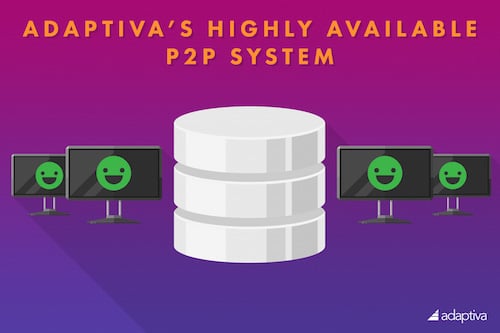
One of the largest concerns an enterprise has with systems management is downloading content over WAN links saturated with business traffic. For the record, I believe OneSite Anywhere does the best job of harvesting free bandwidth while never impacting other traffic, but that’s a topic for another post. Right now, I want to ask you a question:
What’s the oldest and easiest way to save bandwidth?
Don’t send so much data! With Microsoft System Center Configuration Manger (SCCM), that means caching the content so that it only has to be downloaded once to an operating location. If 100 computers in Paris need a piece of content in New York, just download it to one computer in France and let the other 99 computers get it from that one. That’s the key idea behind SCCM distribution point servers (DPs), they reduce WAN transfers very effectively. However, because DPs can be expensive and take a lot of time to manage, many companies deploy Adaptiva OneSite Anywhere to run SCCM without remote DPs. OneSite Anywhere also eliminates the need to download content to an office a second time, or deliver content to offices where it’s not needed—both a huge waste of precious resources.
If Adaptiva OneSite Anywhere eliminates the need for DPs, where are files stored?
OneSite Anywhere, upon simply installing client agents, automatically manages content in a highly available P2P system that exceeds the business continuity and scalability of a server infrastructure. Furthermore, it does so by utilizing resources not needed by end users. OneSite Anywhere has no impact on their performance at all. It does all this without requiring an organization to purchase and maintain even a single extra, expensive remote DP server.
How does OneSite Anywhere decide what content to store where?
Adaptiva OneSite Anywhere utilizes deployment driven delivery, meaning the content only will go where you target it, thereby only taking the minimum amount of resources required. Further, even if a single client is targeted for content, OneSite Anywhere will create redundant copies on other peer systems. Administrators can configure the number of copies to keep. While administrators have the option of specifying which peers will cache content, OneSite Anywhere can save them days of busywork by intelligently selecting systems based on a variety of factors such as chassis, OS, capacity, uptime, etc.
How does OneSite Anywhere NOT take any disk space away from end users?
Once the content gets to peer systems, OneSite Anywhere stores the content in a zero footprint cache. This caching file system harvests all the unused disk space, so OneSite Anywhere actually stores our content in free space! And since it is free space, it’s always available to the user or operating system when needed. People can use 100% of their disk capacity at any time while fully participating in the peer-to-peer network.
How does OneSite Anywhere ensure high availability?
First, as noted earlier, OneSite Anywhere will maintain multiple copies of content at a site. But it also intelligently manages that content. For example, if a user copies a bunch of large files onto their hard disk and takes disk space previously used to cache systems content, OneSite Anywhere removes its content intelligently when giving space back to the user. When removing content from an individual system, OneSite Anywhere will avoid removing the content from the entire office, to help ensure it will never need to be downloaded over the WAN again.
To accomplish this, Adaptiva does not manage individual revolving caches, which arbitrarily remove the oldest piece of content. Rather, OneSite Anywhere clients all have built-in content awareness, meaning our clients know—in real time—every single piece of content every other client has. This allows a system to remove the most prevalent piece of content at an operating location, rather than the oldest in its cache, to be sure all content will remain available at that office. Put another way, if a peer needs to free up disk space, it will remove the content with the greatest number of copies on other systems at that location. On top of that, if the number of copies falls below an administrator specified minimum, additional copies can be created automatically.
Isn’t that basically a SAN?
Yup. We call it a virtual SAN, but I’ve heard other people argue it’s a full blown SAN. It’s possibly better than a SAN because you don’t need to lift a finger to set it up or administer it. It’s self-forming and self-managing. No other product in the world that we know of comes close to delivering this degree of precision, intelligence and automation of secure, enterprise-class peer-to-peer storage. Again, this is all done without taking any space away from end users!
So, can a P2P system be as highly available as a server infrastructure?
Yes, absolutely! OneSite Anywhere’s P2P storage is in many cases more highly available than a server infrastructure. Also, as the number of systems at a site grows, the storage capacity grows automatically with them. On the other hand, if you have servers everywhere, and every server is clustered with both nodes running a hot-swappable RAID array using striping with double parity plus mirroring, that’s probably more highly available than OneSite Anywhere. Short of that, however….
Orchestrating content office-wide in caches that harvest unused disk space is just one way OneSite Anywhere is able to manage systems across an enterprise. Adaptiva does it without impacting the end user, to the extent the users are not even aware of our use of their computers. If you would like to learn more, please contact Adaptiva for either a full demonstration, or a deep dive Q&A about our numerous one-of-a-kind technologies.




